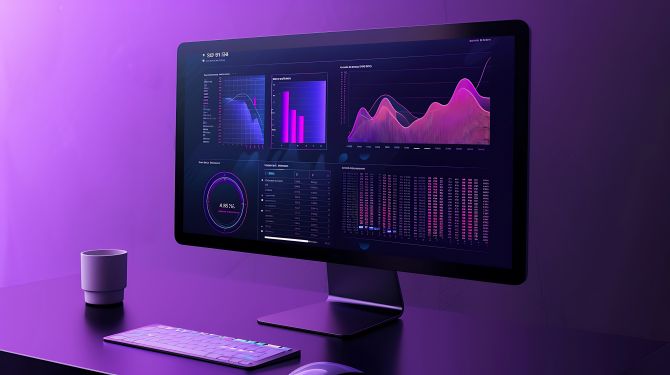
Google Analytics 4 (GA4) has always been our go-to tool for deciphering marketing data, and now, it's gotten even better. With its recent update, GA4 introduces a host of new features designed to help you visualise, understand, and act on your data more effectively than ever before.
In this blog post, we'll delve into the exciting new capabilities of GA4, focusing on the ability to compare up to five metrics side-by-side. We'll explore how this enhancement, along with other key updates, empowers you to:
Gain deeper insights into user behaviour and trends
Identify anomalies and potential issues early on
Track revenue with greater precision
Navigate reports more easily and understand your data better
Let's take a closer look at these features and how they can transform your data analysis and decision-making.
Plot Rows
In the past, getting a 360-degree view of how different metrics interacted within GA4 often involved jumping between multiple reports or exporting data for further analysis. Not anymore. The star of this latest GA4 update is undoubtedly the “Plot Rows” feature. This gem allows you to visualise up to five rows of data simultaneously within your reports, turning those static tables into dynamic, interactive charts. It's like having multiple magnifying glasses on your data, all at once.
How does it work? Simple. Just select the rows of data you're interested in comparing and click the “Plot Rows” option. Voila! GA4 instantly generates a line chart, visually plotting the trends of your chosen metrics over time. This enables you to identify correlations, spot patterns, and uncover insights that might otherwise remain hidden in the raw numbers.
Let's say you want to compare how website traffic, conversions, and bounce rates have evolved over the past month. With Plot Rows, you can see all three metrics plotted on the same graph, making it easy to identify any relationships or potential issues. For instance, a sudden spike in traffic accompanied by a rise in bounce rate could indicate a problem with the quality of your incoming traffic or a misalignment between user expectations and your landing page content.
Anomaly Detection
Even the most experienced digital marketers can't keep their eyes glued to analytics dashboards 24/7. That's where GA4's new anomaly detection system comes in handy, acting as your ever-vigilant data watchdog. This clever tool automatically scans your data for unusual fluctuations, flagging anything out of the ordinary. It's like having an early warning system for your website traffic and engagement.
Imagine a sudden spike in traffic from an unexpected source or a dramatic drop in conversions that seemingly came out of nowhere. GA4's anomaly detection will alert you to these unusual patterns, allowing you to investigate the root cause and take swift action. It's like having a spotlight shining on the outliers in your data, ensuring nothing slips through the cracks.
This proactive approach to data monitoring can make a difference for your business. You can quickly address potential issues before they escalate, or capitalise on unexpected opportunities to drive even better results. You can proactively manage your digital marketing strategy and keep your website performance on track by promptly responding to anomalies.
Remember, though, that while GA4's anomaly detection is a powerful tool, it's essential to investigate the context behind each flagged data point. A sudden increase in traffic might be due to a successful marketing campaign, while a drop could be attributed to a seasonal trend or a technical glitch. The key is to understand the "why" behind the anomaly and use those insights to inform your decision-making.
Improved Report Navigation Understanding
Let's face it, even the most seasoned data analysts can sometimes find themselves lost in the labyrinth of Google Analytics reports. Recognising this, Google has introduced a seemingly small but impactful improvement: hover-over descriptions for report titles. It's like having a friendly tour guide whispering insights as you navigate the platform.
These brief explanations provide valuable context, offering a quick snapshot of each report's purpose and the metrics it contains. Think of them as handy labels that instantly clarify what you're looking at, saving you precious time and eliminating any guesswork. But it doesn't stop there. These descriptions also include links to more detailed information, allowing you to dive deeper into any specific report that piques your interest. It's akin to having a comprehensive encyclopaedia at your fingertips, ready to answer any questions that may arise during your data exploration journey.
This seemingly minor enhancement can significantly impact how you interact with GA4. It streamlines the navigation process, reduces confusion, and ultimately, helps you gain a clearer understanding of your data. No more fumbling around trying to decipher report titles; now, you have a helpful guide illuminating your path.
Key Event Marking in Events Report
GA4's new ability to mark significant events is like adding little flags to your data timeline, allowing you to pinpoint and track important occurrences with ease.
Accessed through a simple three-dot menu at the end of each event row, this feature empowers you to identify and monitor specific actions users take on your website. Did you launch a new marketing campaign? Mark it. Is there a particular product or service you want to keep a close eye on? Mark it. This streamlined approach helps you declutter your data and focus on the metrics that matter most.
Let's say you've recently rolled out a new product feature. By marking the associated event, you can easily track its adoption rate, understand user engagement patterns, and measure its overall impact on conversions. This allows you to make informed decisions about future improvements and iterations, ensuring your product strategy is always aligned with user behaviour and needs.
New Transactions Report For Revenue Insights
E-commerce businesses, rejoice! Google Analytics 4 has heard your calls for more detailed revenue tracking, and they've delivered. The brand-new Transactions report offers a granular look into your sales data, breaking down each transaction with the help of the transaction_id parameter.
This means you can go beyond just seeing the total revenue generated. You can dive deeper into individual transactions, understand how different products or services are performing, identify trends in purchasing behaviour, and even spot potential areas for improvement in your sales funnel. It's like having a magnifying glass for your e-commerce data, allowing you to pinpoint precisely where your revenue is coming from and where there might be growth opportunities.
Imagine being able to track the journey of a specific transaction, from the initial product view to the final purchase. With the new Transactions report, you can see which marketing channels or campaigns are driving the most valuable transactions, identify which products are frequently purchased together, and even track the average order value for different customer segments. This treasure trove of information can empower you to make more informed decisions about your pricing, product offerings, and marketing strategies.
Scope Changes in Acquisition Reports
Google Analytics has always been about helping us understand where our website visitors come from. In this latest GA4 update, they've refined their acquisition reports to provide an even clearer picture, separating user-related metrics from session-related metrics.
It's like decluttering your workspace, creating two distinct areas: one for your ongoing projects (users) and another for the tools you're currently using (sessions).
The User Acquisition report now focuses on the people visiting your site: total users, new users, and returning users. On the other hand, the Traffic Acquisition report zeroes in on the sessions themselves: sessions, engaged sessions, and sessions per event.
This separation allows for a more targeted analysis. For instance, you can now easily track how many new users are coming from a specific marketing campaign, or see how engaged sessions vary across different traffic sources. It's about gaining a more granular understanding of your audience and their behaviour on your site.
In the end
The latest GA4 update is a testament to Google's commitment to providing marketers with the tools they need to truly understand their data.
It's time to embrace these enhancements and unlock the full potential of your GA4 data. Experiment, explore, and don't hesitate to reach out to experts if you need guidance along the way.
Whether you're seeking professional website analytics services or just want some personalised advice on how to get the most out of the latest GA4 update, our team of experts is here to help.
Don't hesitate to fill out our free contact form, and we'll be in touch to discuss your specific needs and goals. Let's transform your data into actionable insights that drive real results!






